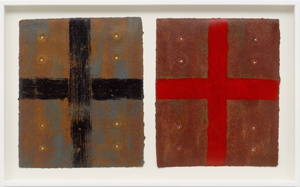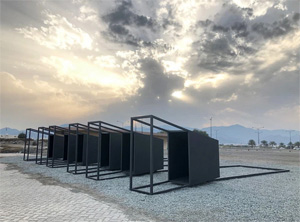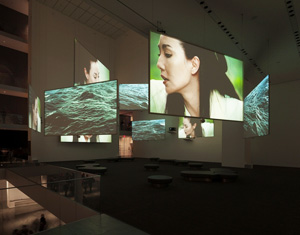8.16.24 — Music and Light
To wrap up from last time, nothing matters more to the 2024 Whitney Biennial than globalism and gender. Well, that and not AI but multimedia. Not that politics is anything new to a biennial, and neither is controversy.
The 2000 Biennial targeted Rudy Giuliani, who took his usual potshots at art in return. Artists walked out of the 2019 Biennial over a board member’s role in the arms industry and protested the 2017 Whitney Biennial over a rendering of the death of Emmett Till.  Politics is news, by definition, but can diversity still make the headlines? Can it take a stand on the fluid and permeable without sinking? If so, does that make it “same old, same old” after all?
Politics is news, by definition, but can diversity still make the headlines? Can it take a stand on the fluid and permeable without sinking? If so, does that make it “same old, same old” after all?
Some have thought so, while others have found the biennial’s quality at odds with its message. I can sympathize. Many works do hector, like a screed on colonialism from Demian DinéYazhi’ in neon. Others may refuse to hector, but wall text does not. There the work takes a back seat to its supposed origins in the issues of the day. That can make art needlessly obscure, but it makes all the clearer how much art conveys issues of the heart.
Artists, then, can still win out. The biennial can take credit, too, for extending diversity in American art from blacks and women to LGBT+ and other nations. That expansion is at its best in video that refuses to lecture, like Julien’s. Clarissa Tossin connects Mayan artifacts to life in Guatemala today, while Seba Calfuqueo sees Chile’s heartland as if for the first time. They may come down to little more than travel ads, but have a nice trip. Dora Budor lends New York’s most exclusive and abhorrent real estate deal, the Hudson Yards, a spooky appeal.
Others are shriller and less coherent. Sharon Hayes tapes classroom discussions (about gender), but they look more like episodes of The View. Lewis listens to church bells in Italy and hears only the dominance of Western civilization. I can feel the puzzlement and pain as Diane Severin Nguyen grapples with war crimes, but only if I get past her ham acting. Still, the impact of video points to what could be the biennial’s greatest achievement. It takes light, sound, multimedia, and collaboration seriously.
JJJJJerome Ellis has a lot of J’s and an open invitation to respond to the entire biennial in sound, while Andrews already fills the stairs with choral music somewhere between speech and song. Nikita Gale lends a piano without strings her lively Tempo Rubato (Stolen Time). She adopts a literal translation of the musical term for loose, expressive rhythm, but then in this life time is always short. Madeleine Hunt-Ehrlich honors a Caribbean philosopher of “Négritude” with nothing more than slowly brightening and dimming light. When she calls it Too Bright to See, she could be speaking of race, philosophy, or the cycle of day and night. Like James Turrell with natural and artificial light, she is teaching herself and others to look.
Too much else is business as usual or, worse, a loaded agenda. Too much, too, is out of the picture. Diversity is important, but it is not everything. The last few years of controversy, classics, and creative hanging are looking better all the time. Still, there may never be a balanced biennial, and there never should be. For now, there is more than enough light to see.
Read more, now in a feature-length article on this site.

